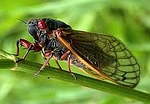BroodII Eruption Predicted For Our Area
By the time you read this, the place could be carpeted with cicadas driving you nuts with noise — music to their ears, but not to ours — more like the sound of a roaring train that never quite passes all the way through.
What the? you might ask.
The what is the eruption of magicicadas at the end of their seventeen year underground cycle due in our area anywhere between mid-April and the end of May. These cicadas are not locusts; they are little living (harmless) time bombs belonging to the leafhopper and spittlebug family. Their last eruption occurred in 1996.
Every year we have cicadas, but magicicadas are different in a few key ways. They appear in the spring in seventeen-year cycles, not every summer, and can be so numerous, theyʼre counted in the millions per square mile. They have red eyes and red wing veins and darker bodies than does the annual “dog-day” variety.
There are six distinct broods spread across the mid-Atlantic. Brood II, as this population of magicicadas is labeled, extends from central Virginia through southeast Pennsylania, northern New Jersey, southern New York and Connecticut, with areas of concentration that include the lower Hudson Valley. Entomologists are interested in learning through the Cicada Database Project whether their territories have shifted over time or with changes in the climate. A number of projects are underway using GPS and the internet, two technologies in their infancies in 1996, to study the habits of magicicadas.
When cicadas emerge from the ground, they shed their nymphal skin, that brown form-fitting husk found clinging to vegetation. After they harden, they crawl up the trunks of trees where they begin the process of finding a mate. Only the males call — when magicicadas are chorusing in unison, the decibel count can reach as high as 120, more than the OSHA limit acceptable in the work place without hearing protection — and females respond with visual wing flicks. Each of the more than three thousand known species of cicada has its own call.
When the male succeeds in attracting a mate, he begins a lower register courtship song, and then after she accepts him, she lays hundreds of fertilized eggs in the tips of tree branches. At this point, the adults die and litter the ground with their carcasses. The eggs will hatch two months later and the nymphs will also drop to the ground and burrow down as far as one to eight feet deep, to feed off the roots of trees until the next eruption due in 2030.
It is believed that cicada nymphs cannot keep track of time as humans understand time, but they may be able to track seasonal changes through temperature. Another theory postulates they are able to track changes in their host feeding plants from which they take their cues for the timing of their emergence.
For an eruption to occur, the ground must be at least 64 degrees Fahrenheit at a depth of 8 inches, so you may see cicadas emerging in sunny spots in your yard before the ones in cooler shady spots are ready. Also, you must have deciduous trees. Cicadas prefer maple, ash, willow, cypress and oak, from which they drink tree sap. Their above ground survival strategy is known as “predator satiation, ” or producing so many individuals that every massospora cicadina fungus, cicada killer wasp, praying mantis, bird, squirrel, and human can eat cicadas until theyʼre ready to throw up and there will still be plenty left over for breeding.
You may not have known that cicadas sweat, much as humans do, or that they have five eyes, the two large ones easily seen and then three little oscilli located on the forehead between them. While they do not bite, they may mistake you for a tree, even with all those eyes, and try to drink sap from you. Just remember that the creature is confused, not aggressive, and will do no harm.
There are practical considerations concerning cicada eruptions that stem from their sheer numbers. The website www.cicadamania.com offers a Cicada Wedding Planner for those of you planning outdoor weddings this spring and a Cicada Emergence Date Calculator that was 80% accurate last time around. If you are interested in participating in the Cicada Mapping Project sponsored by National Geographic, go to www.magicicada.com for more information.



